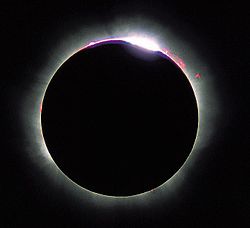
"The Sun Is Blotted From the Heavens"
Solar eclipses have been recorded as important events by humans for millennia. References have been found in some of our earliest texts, including ancient Chinese academic documents and even a line from Homer's Odyssey that declares, "The sun is blotted from the heavens."
It's easy to imagine how our earliest ancestors must have reacted to the sudden disappearance of the sun, and over time the phenomenon has been seen as both fascinating and terrifying, a signal of the displeasure of the gods, or an omen of bad things to come.
These rare, mesmerizing sky shows result when the moon aligns between the Earth and the sun, blocking the sun's light and casting a shadow on our planet. As Earth spins, this shadow races at some 1,400 miles an hour (2,250 kilometers an hour) along a line called the path of totality.
Only sky watchers within this arc—typically 10,000 miles (16,000 kilometers) long and just 100 miles (160 kilometers) wide—experience a total eclipse. People near it see a partial solar eclipse in which not all of the sun is blotted out. Those farther away see nothing at all.
A total eclipse begins as a barely perceptible nibble out of the sun. Over the next hour or so this blemish widens and eventually consumes the sun, turning day to night. This state, called totality, can last as long as seven and a half minutes, although it is usually half that.
During totality, the only visible part of the sun is its corona, the normally unseen outer atmosphere that shimmers in the darkness like a fiery ring. When the sun begins to reappear, there is often a sparkling glow in one spot along the corona that creates what's known as the diamond ring effect. Within about an hour, daylight is restored.
Only During the New Moon

Eclipses happen only during the new moon phase, when the moon moves to the side of Earth facing the sun. However, because the moon orbits Earth at a slight angle, the three bodies will only periodically line up on the same plane to create an eclipse.
Interestingly, total eclipses are only possible on Earth because of a fortuitous coincidence: The moon's diameter and distance from Earth make its relative size just big enough to cover the sun. If the moon were any smaller or farther away, we would only see partial eclipses. In fact, in a billion years or so, the moon will have drifted so far from Earth that solar eclipses will no longer occur.
Another type of solar eclipse, the annular eclipse, occurs when the moon's elliptical orbit carries it far enough from Earth that it becomes too small to totally block the sun. In this case, the eclipse appears as a blackened circle rimmed by sunlight.
Total eclipse occurs every one or two years, while total and partial eclipses together average about two and a half incidences per year. But because they are visible from such a small area on Earth each time, the chance of observing a total eclipse from any single spot is less than once in a lifetime.
Seeing a solar eclipse can be an unforgettable experience, but experts urge caution. Looking directly at the sun through a telescope or binoculars (or even the naked eye) can cause eye damage and even permanent blindness.
http://video.google.com/videoplay?docid=-4909789369249504644
No hay comentarios:
Publicar un comentario